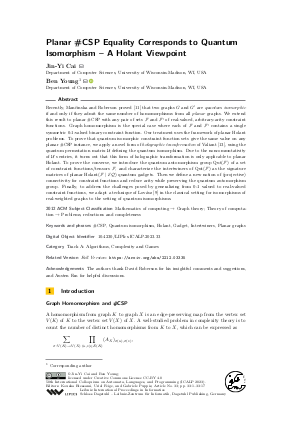@InProceedings{cai_et_al:LIPIcs.ICALP.2023.33,
author = {Cai, Jin-Yi and Young, Ben},
title = {{Planar #CSP Equality Corresponds to Quantum Isomorphism - A Holant Viewpoint}},
booktitle = {50th International Colloquium on Automata, Languages, and Programming (ICALP 2023)},
pages = {33:1--33:17},
series = {Leibniz International Proceedings in Informatics (LIPIcs)},
ISBN = {978-3-95977-278-5},
ISSN = {1868-8969},
year = {2023},
volume = {261},
editor = {Etessami, Kousha and Feige, Uriel and Puppis, Gabriele},
publisher = {Schloss Dagstuhl -- Leibniz-Zentrum f{\"u}r Informatik},
address = {Dagstuhl, Germany},
URL = {https://drops.dagstuhl.de/entities/document/10.4230/LIPIcs.ICALP.2023.33},
URN = {urn:nbn:de:0030-drops-180851},
doi = {10.4230/LIPIcs.ICALP.2023.33},
annote = {Keywords: #CSP, Quantum isomorphism, Holant, Gadget, Intertwiners, Planar graphs}
}

 Creative Commons Attribution 4.0 International license
Creative Commons Attribution 4.0 International license






